Diving into the world of waterfowl hunting, one truth stands out: success is often determined by how convincing your decoy spread is. Did you know that ducks rely on their keen eyesight and social instincts to decide where to land? A poorly chosen or placed decoy could mean the difference between bagging your limit or going home empty-handed.

That’s why choosing the best duck decoys for 2025 is critical for serious hunters. With advancements in design, durability, and realism, today’s decoys offer an edge like never before. Whether you’re targeting mallards in the marsh or pintails on open water, the right setup can elevate your hunting game to a whole new level.
In this article, we’ll uncover the top-rated duck decoys of the year, breaking down their features, benefits, and why they stand out in the field. Ready to lure in the flock? Let’s dive in!
List of The 6 Best Duck Decoys
1. Mojo Butt Up Rippler Realistic Duck Decoy
Best Seller
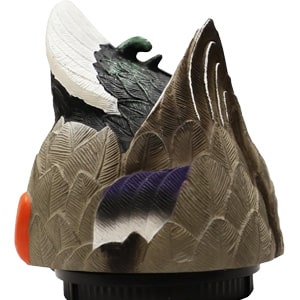
⚙ Main Specifications
- Design: Realistic feeding duck motion
- Feature: Creates ripples to mimic natural behavior
- Battery: Lasts 6-8 hours (4 AA batteries required, not included)
- Use: Perfect to enhance your decoy spread
2. Flambeau Storm Front 2 Mallard Decoys (6-Pack)
Best Budget
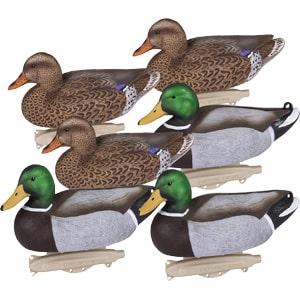
⚙ Main Specifications
- Type: Floating Mallard decoys, 6-pack
- Paint: UVision technology for realistic UV plumage
- Design: High-definition by master carvers
- Keel: 4 tie-off points, adjustable anchor eyelet
- Includes: 2 active drakes, 1 semi-resting drake, 3 semi-resting hen
3. Final Approach Last Pass Mallard Floaters Decoy (12 Pack)
Detail & Size
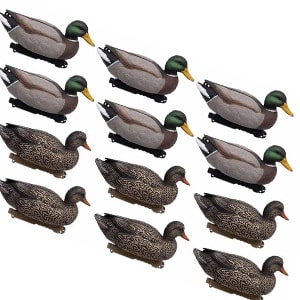
⚙ Main Specifications
- Type: Lightweight floating decoys (12-pack)
- Design: Carved by Pat Godin
- Durability: Rugged one-piece with weighted keel
- Use: Easy to transport, boosts spread numbers
- Includes: 6 drakes, 6 hens
4. MOJO Outdoors Wind Duck Decoy Brown
Premium One

⚙ Main Specifications
- Type: Wind-driven Mallard decoy
- Wings: Spins in 5+ MPH breeze
- Design: Lightweight, rugged, no batteries needed
- Includes: 4-ft support pole
- Use: For non-motorized decoy areas
5. RioRand Realistic Plastic Duck Hunting Decoy
Stability
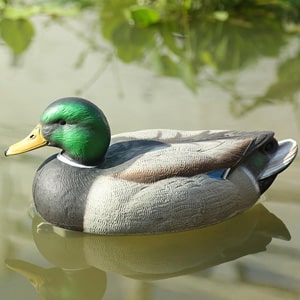
⚙ Main Specifications
- Type: Floating Mallard decoy
- Design: Realistic colors and details
- Use: For gardens, ponds, and lawns
- Material: Durable plastic
- Easy Placement: Simple to use and position
6. Avian X Green-Winged Teal Realistic Floating Duck Decoys for Hunting
So Realistic!!
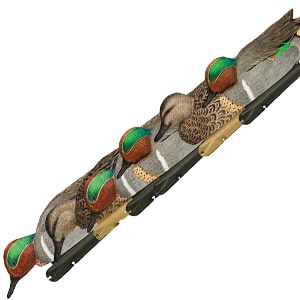
⚙ Main Specifications
- Design: Realistic with vibrant paint
- Motion: Natural movement with weight-forward keel
- Use: Ideal for ponds, marshes, and open water
- Durability: Rugged, season-long reliability
- Setup: Easy, natural water placement
Related Post:- Best Turkey Decoys
Related Post:- Best Deer Decoys
What is a Duck Decoy and Why Do Hunters Need It?
A duck decoy is a lifelike imitation of a duck used by hunters to attract real ducks. It can be a floating decoy on water or a stationary one on land, designed to mimic the movement and appearance of real ducks.
Why Do Hunters Need Duck Decoys?
- Attract Ducks: Ducks are naturally social birds. They’re drawn to groups of other ducks. Decoys create that illusion of a safe, feeding flock, which encourages real ducks to land nearby.
- Increase Hunting Success: By adding decoys to their setup, hunters can improve their chances of attracting ducks, making the hunt more successful.
- Realistic Motion: Some decoys are designed to move with the wind or water, mimicking the natural motions of ducks. This movement makes them even more believable to passing birds.
Things to Consider When Choosing a Duck Decoy
When selecting a duck decoy, there are several important factors to think about to make sure you get the best one for your hunting needs. Here’s a detailed breakdown in simple terms:
1. Type of Duck
You’ll want to choose decoys that match the type of duck you’re hunting. Different species have different features, so pick the decoys that look most like the ducks in your area.
Example: If you’re hunting mallards, go for mallard decoys. For teal hunting, choose teal decoys. The more specific the decoy, the more convincing it will be.
2. Decoy Material
Decoys come in different materials like plastic, foam, or even wood. Plastic is common because it’s durable and lightweight, while foam is known for being highly realistic.
Example: Flambeau Outdoors Storm Front Mallard Decoys are made from tough plastic that lasts, while RioRand Realistic Duck Decoys are made from a durable plastic that’s designed to last season after season.
3. Realism and Paint Quality
The more realistic the decoy, the better it will attract ducks. Look for decoys with vibrant, long-lasting paint that mimics the natural plumage of ducks. Some decoys even use special UV paint to mimic how ducks see.
Example: Avian X Green-Winged Teal Decoys use high-quality paint that looks just like real ducks, which helps fool the birds into landing near your spread.
4. Motion Features
Motion adds a lot of realism to your decoy setup. Some decoys are designed to float and move naturally with the wind or water, while others may have spinning wings that attract ducks from a distance.
Example: MOJO Outdoors Wind Duck Decoy is a wind-driven decoy that spins its wings in breezes as light as 5 MPH, adding realistic movement without needing batteries.
5. Size and Weight
Consider the size and weight of your decoys, especially if you need to carry them to your hunting spot. Some decoys are lightweight and compact, making them easier to transport, while others are bigger and more durable.
Example: Final Approach Last Pass Mallard Floaters are lightweight, making them perfect for long walks to hunting spots, while still providing a realistic look.
6. Durability
Look for decoys made of tough materials that can handle rough weather, including cold temperatures, rain, and high winds. They should be able to stand up to repeated use over time.
Example: Flambeau Outdoors 8036SUV Storm Front Mallard Decoys are designed with durability in mind, featuring a rugged construction that lasts for multiple hunting seasons.
7. Price and Value
Decoys can range in price, so it’s important to find one that fits your budget without sacrificing quality. Sometimes, spending a little more for a durable, realistic decoy pays off in the long run.
Example: While decoys like the MOJO Outdoors Wind Duck Decoy might be a little pricier, they’re worth the investment because they work well in light winds and are easy to use.
Frequently Ask Questions:-
1. What is a duck decoy used for?
A duck decoy is a fake duck used by hunters to attract real ducks. It’s placed in water or on land to make ducks think other ducks are around, which encourages them to land nearby.
2. How do I choose the best duck decoys?
When picking a decoy, think about the type of duck you’re hunting, like mallards or teal. Check the material (plastic is common) and whether it moves (like spinning wings). Make sure the paint looks realistic and the decoy is durable enough for your weather conditions.
3. Why should I use motion decoys?
Motion decoys move like real ducks, which helps attract more ducks. They might spin in the wind or move in the water to look like ducks are feeding or resting.
4. Can I use duck decoys in all kinds of weather?
Yes, most good decoys are built to handle different weather like rain, wind, or cold. Look for decoys that are sturdy and can last in tough conditions.
5. How do duck decoys help with hunting?
Duck decoys make it look like there’s a group of ducks around, which draws in real ducks. The more realistic your decoys, the more likely ducks will land near your setup.
6. What’s the best material for duck decoys?
Duck decoys are usually made from plastic, foam, or wood. Plastic is light and durable, foam looks more realistic, and wood is strong but heavier. Choose the material based on how realistic and easy to transport you need your decoys to be.
7. Do I need different decoys for different kinds of ducks?
Yes! It’s important to use decoys that match the type of duck you’re hunting. For example, use mallard decoys for mallard hunting, and teal decoys for teal. This helps make your spread look more realistic to the ducks you want to attract.
8. Are battery-powered or wind-driven decoys better?
Battery-powered decoys move consistently and are great for calm days, but some places don’t allow motorized decoys. Wind-driven decoys are a good option because they work with light wind and don’t need batteries.
9. How many duck decoys should I use?
A spread of 6-12 decoys is usually enough, but if you’re hunting in a big area, you might want to use more. The goal is to make your setup look like a real group of ducks.
10. How do I take care of my duck decoys?
Clean your decoys after each hunt, especially if they get muddy or wet. Store them in a dry place, and avoid using harsh chemicals that could damage them. Taking care of your decoys will help them last longer and stay effective for future hunts.
Conclusion:
Choosing the right duck decoy depends on several factors: the type of ducks you’re hunting, the material and realism of the decoys, how easy they are to carry, and how durable they are for different weather conditions. By considering these things carefully, you can pick the decoys that will give you the best chance of attracting ducks and having a successful hunt.
Leave a Reply